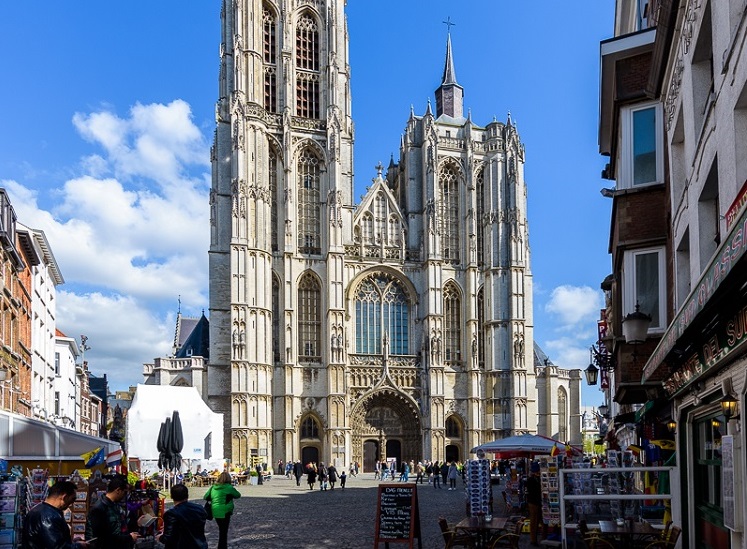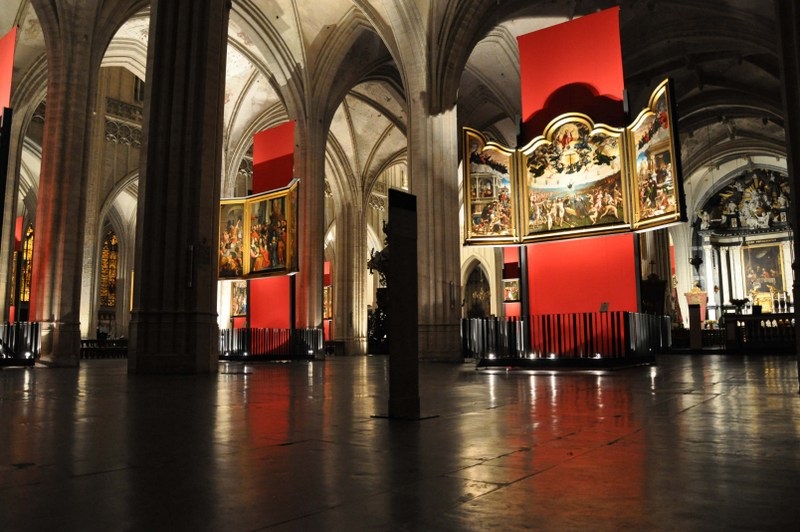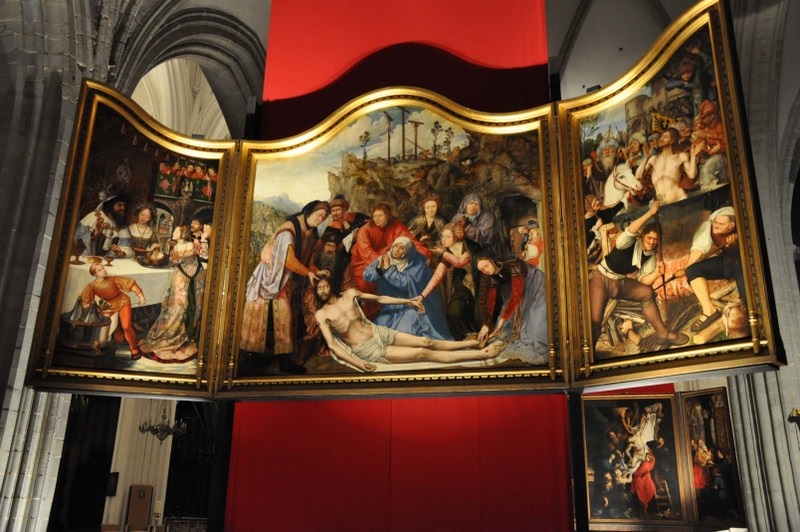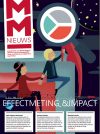
Luc Roymans © Onze Lieve Vrouwekathedraal Antwerpen
The Cathedral of Our Lady in Antwerp is a major attraction in the city, for religious as well art historical reasons. The cathedral owns a number of paintings by Rubens, which for the past seven years have been part of a highly successful exhibit, together with a number of loaned pieces from the Royal Museum of Fine Arts Antwerp. With the current exhibit ending in 2019, the cathedral is reenvisioning ways in which it can exhibit its own prized collection within a sacred space.
The Cathedral of Our Lady in Antwerp welcomes more than 300,000 visitors each year, coming from all over the world. More than half of those visitors are foreign, coming mostly from the Netherlands, France and Germany. The cathedral is also a popular destination on the travel route of American and Japanese tourists.
The exploitation of the cathedral is self-sufficient. It has been professionalized in the past 25 years with a large staff. The cathedral of Our Lady in Antwerp is open every day of the year, safe for January, 1th. The cathedral welcomes visitors with a professional reception, information leaflets and audio guides, with an eye towards the ‘The Descent of the Cross’ by Pieter Paul Rubens, but also other aspects of the cathedral, such as its history and sacred atmosphere.There are also temporary exhibitions, several guided tours in different languages, as well as a shop with catalogues, postcards, merchandising. A lot of consideration and care goes into the look and appearance of the cathedral, with strict caretaking by our cleaning and technical staff.
An artistic reunion

Mark Walker Night View © Onze Lieve Vrouwekathedraal Antwerpen
In 2009 the cathedral, in collaboration with the Royal museum of Arts, put together an ambitious exhibition to commemorate the founding of the diocese of Antwerp, five hundred years earlier. This partnership with the museum was a natural one: at the end of the French annexation of the city, an important part of the patrimony of the cathedral was assigned by the government to the predecessor of what would later become the prestigious Royal Museum of Fine Arts Antwerp. The museum agreed to relocate eight of the finest altarpieces from her collection to the cathedral for this exhibition, were they originally belonged: a ‘reunion’ on an exceptional scale. Next to these works, the Cathedral shows eight works that are featured in its permanent collection. These are impressive works, mainly triptychs, measuring up to five meters wide and three meters high. This unique ‘in situ’ reunion gives visitors a spectacular overview of masterpieces created by the Antwerp school during the Golden Age. The exhibition was given the fitting title: ‘Reunion: From Quinten Metsys to Peter Paul Rubens. Masterpieces from the Royal Museum reunited in the Cathedral’.
A new mission
In 2019 the cathedral faces a new challenge, when the Royal Museum reopens and the loan period of the altarpieces comes to an end. After a successful ten year run, the cathedral will have to rethink the exhibition. It is an interesting exercise to give new meaning to the exhibition and at the same time keeping it relevant for today’s society.
Because of the complexity of the cathedral’s structural organization, the cathedral brought several stakeholders – from the local guides association to the parish of the cathedral – together. The past few years we worked on a text stating the mission of the cathedral as a whole. The mission text consists of three paragraphs, ranked in order of importance: the cathedral as bishop church, the cathedral as a cultural treasure to all visitors and the cathedral in dialogue with society. The core-business of the cathedral is its service to church building within the diocese of Antwerp.
Christian Devos:
Can the cathedral take on a role in the changed world that is analogous to the function of a Gothic structure of the Middle Ages? How can it avoid being reduced to a time machine that relates how things were in the past?First and foremost, the Antwerp Cathedral of Our Lady is the bishop church of the diocese in Antwerp. At the service of the diocese community, the cathedral is also a parish church. As such, the cathedral wants to lead by example in the field of liturgy, proclamation of faith and charity. Secondly, the cathedral is a sacred place in a rich historic and cultural environment. By providing visitors a quality introduction to its rich cultural heritage, the cathedral wants to stimulate education, personal development and spiritual growth. Thirdly, in the spirit of its Christian identity, the cathedral wants to open the dialogue with everybody, no matter race or beliefs, in a hospitable way. It wants to be a meeting ground, a place where people can be involved, but also be anonymous. With respect to any belief, it invites people to philosophical exchange, and contributes to general welfare, with special attention for people in need.
A Christian story
Researching the archives of the exhibition ‘Reunion’ made us realize that our vision today has evolved, compared with 2009. The original plan of communication tells us that “we have to make sure that the cathedral is not only looked upon as a place of liturgy, but also a site of cultural heritage” and further “[w]e will focus on the richness of the Antwerp School and on evoking the cathedral interior of that day and age”. A SWOT analysis revealed a weak spot: “[a] religious exhibition in a religious context might be too much for a potential visitor”. In part, these goals still stand. Back in 2009, there was a clear focus on the cultural and historical value of the pieces of art. Today, with our new mission statement, we would like the treat the Christian iconography with the same level of attention.

Mark Walker Reünie Metsijs © Onze Lieve Vrouwekathedraal Antwerpen
In the words of our pastor Bart Paepen: “Today a rift exists between the profane and the sacred. Whoever enters the cathedral is generally not seeking the model of the ideal community as promised by the biblical God. Behold the challenge for whoever is responsible for the Christian and cultural heritage that the main church of the diocese of Antwerp contains. Can the cathedral take on a role in the changed world that is analogous to the function of a Gothic structure of the Middle Ages? How can it avoid being reduced to a time machine that relates how things were in the past? How can it ensure that the cathedral does not turn into a museum, where visitors enjoy yesterday’s beauty without making the connection to their own existence?”
For example, the text that is presented next to the altarpiece ‘Lamentation’ by Quinten Metsys, tells the size, the date, something about the importance of the painter and the quality of the picture concerning light and color. Although we consider this as relevant information, it says nothing about the image itself: why did Metsys choose a ‘Lamentation’, and most of all, what is the meaning and importance of a ‘Lamentation’ in Christian iconography? Why are Jesus, John and Mary presented in first century clothing and the others wearing sixteenth century clothing? And how does this detail contribute to making the connection to the viewers’ existence?
What are our specific goals with this new strategy? Not a spectacular growth of tourism per se. What we want, is to augment the quality of the visits to the cathedral by welcoming visitors in a cathedral with important historic patrimony that has a Christian story to tell. In this way, we might avoid the question that is sometimes posed to us by tourists: ‘Is the cathedral still in use?’
[Editor MMNieuws:] This article is an adaptation of the autor’s presentation at the Conference on Religious Heritage and Tourism: How to increase religious heritage tourism in a changing society, october 5-7 2016 in Utrecht, The Netherlands.
